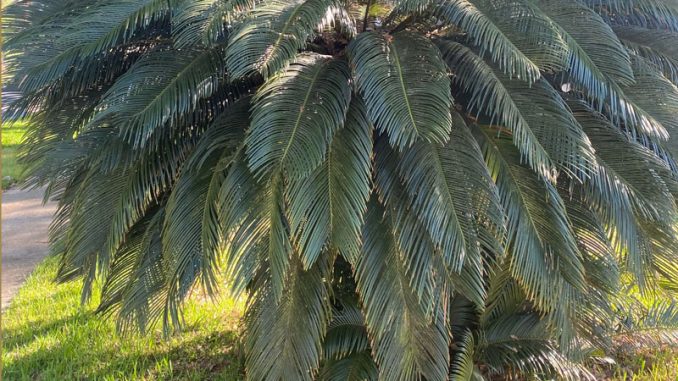
I remember as a child travelling through the piney woods of Arkansas from Texas to Mississippi to see my dad’s family. I would get tired and fall asleep. At the time I thought the trees were boring. However, the truth is that you can tell a lot about an area by its trees. I remember this time last year when I texted my mom a picture of our new home (she knew I was moving but not where yet) the first thing she noticed was the palm tree in front of it. She exclaimed, “You have a palm tree! I am never going to have to see snow again.” A few months later I decorated that very palm and it is now the “sign” that marks our driveway as home. Now we say it is our “see-go” (sago) because it sees us go and it sees us come.
Trees witness stories and tell some of them to us if we listen. Think of the trees twisted by storms or the ones that have grown together over time. Think of the ones with gnarly scars telling the stories of limbs lost and of the ones who at time house what seem to be hundreds of birds. When trees fall or are cut the rings inside tell us the story of years gone by—times of want and times of plenty. Can you imagine the stories the trees in City Park could tell us, or even that beautiful mature Palm in the neutral ground outside the church? As we approach Holy Week the stories of two types of trees stand out—the story of the palm trees who gave up their fronds to praise Jesus as folk shouted “Hosanna” and the story of the “tree” upon which Jesus died following the shouts of “Crucify him, crucify him” perhaps from some of the very same mouths. In the Garden of Gethsemane stands an ancient olive tree that was there to hear Jesus’ prayer the night he was arrested.
Scripture too is shaped by trees from the beginning to end. In Genesis 2:8-9 we read these words: “The LORD God planted a garden in Eden in the east and put there the human he had formed. In the fertile land, the LORD God grew every beautiful tree with edible fruit, and also he grew the tree of life in the middle of the garden and the tree of knowledge of good and evil.” Then in Revelation 22:1-2 we find these words: “Then the angel showed me the river of life-giving water, shining like crystal, flowing from the throne of God and the Lamb through the middle of the city’s main street. One each side of the river is the tree of life, which produces twelve crops of fruit, bearing its fruit each month. The tree’s leaves are for the healing of the nations.” Thus the story of God’s love for us begins with God placing humanity in a garden filled with trees that sustain us physically and ends with the story of God’s love bringing us home to a place filled with trees that sustain us eternally and brings healing to the nations. Yet what makes it possible is that center tree: The Old Rugged Cross. This month, as we conclude the Lenten season, celebrate Palm Sunday and Easter and then begin a new worship series inspired by trees, I want to encourage you to take a few moments and to enjoy the beautiful trees…whether they line the street…are in your yard or the park. Allow God to use them to remind you that God loves us and not only sees us go and come, but walks with us every step of this way in this life and the next. Amen.
According to Rev. Adam Weber trees are the second most mentioned living things in all of scripture

